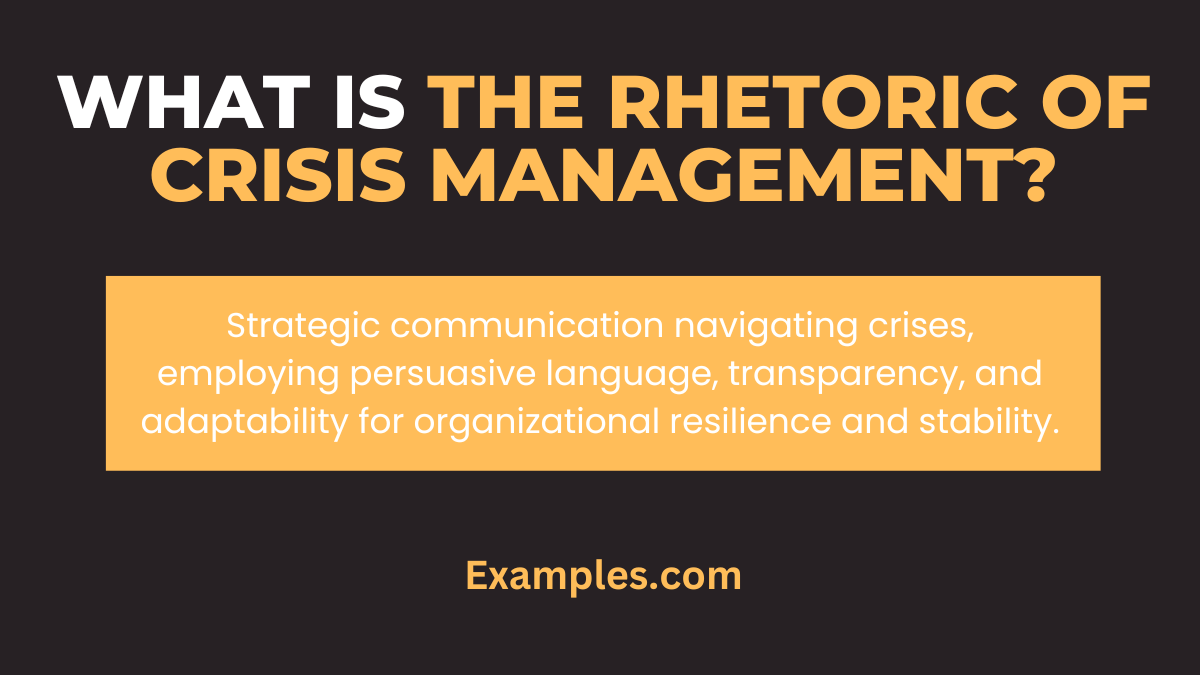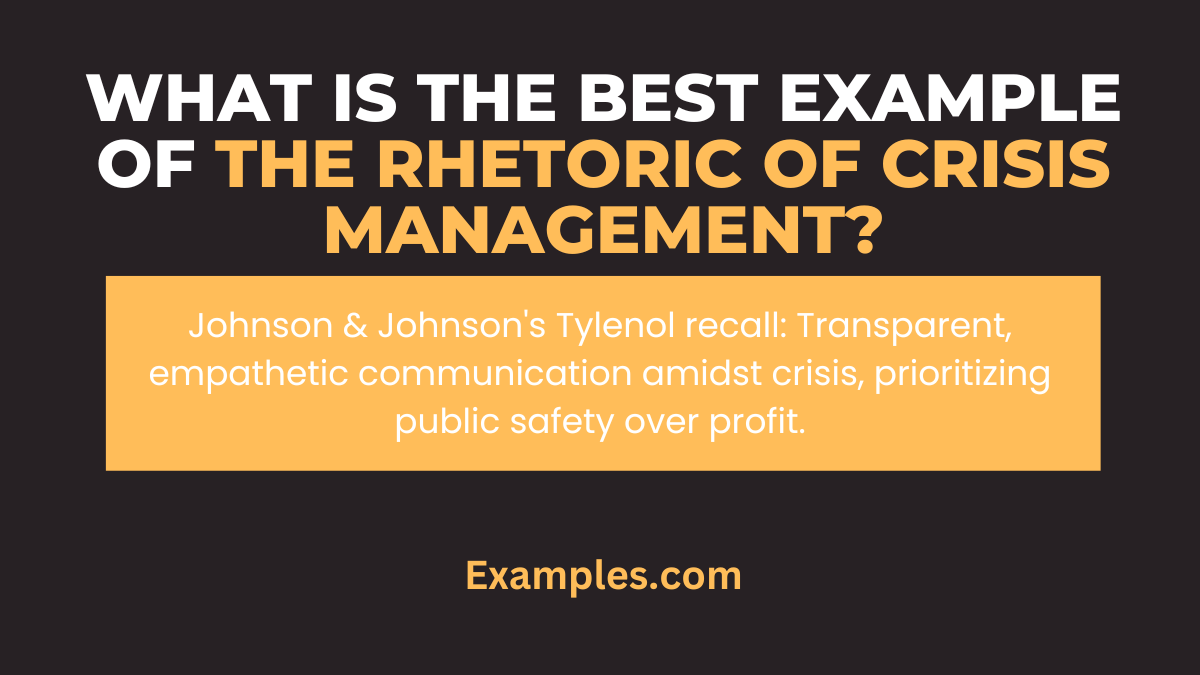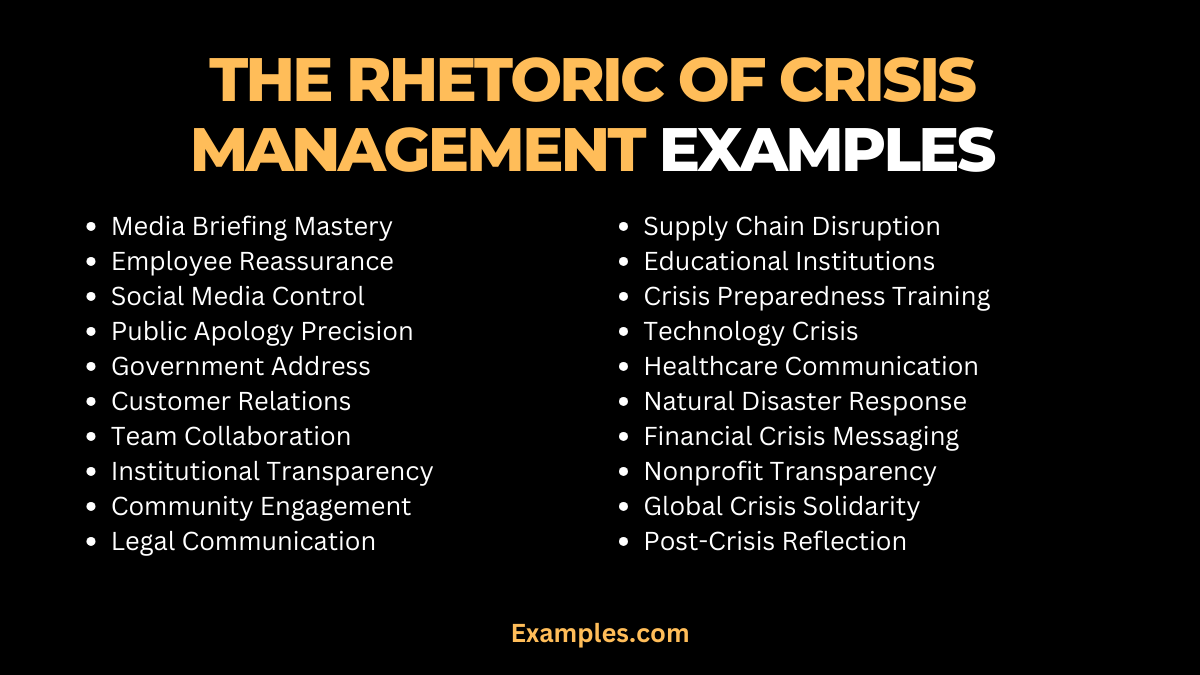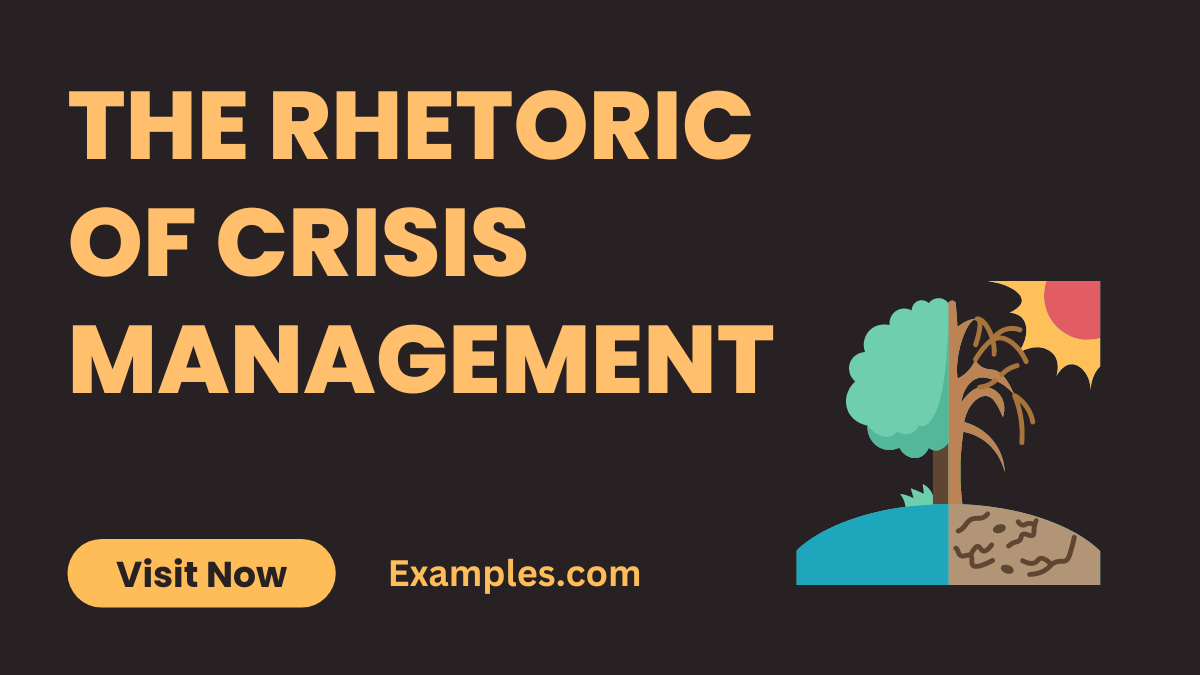19+ The Rhetoric of Crisis Management Examples
In the dynamic landscape of crisis management, mastering the nuanced art of communication is paramount. This comprehensive guide delves into “The Rhetoric of Crisis Management,” providing actionable insights and illuminating examples that transcend theory. Navigate the intricacies of crisis response with finesse, understanding how effective communication examples play a pivotal role. From strategies to real-world scenarios, this guide empowers you to wield communication as a powerful tool in the face of challenges. Welcome to a transformative journey where words become a shield in times of crisis.
What is The Rhetoric of Crisis Management?

In straightforward terms, the rhetoric of crisis management encompasses the strategic use of communication during challenging situations. It’s the art of choosing and employing words, tones, and methods to navigate crises effectively. This approach involves not just what is said but how it’s conveyed, recognizing the profound impact communication has in managing and resolving crises. In essence, it’s a skillful blend of words and strategy aimed at guiding individuals or organizations through turbulent times with clarity and purpose.
What is The Best Example of The Rhetoric of Crisis Management?

In the annals of crisis management, the Johnson & Johnson Tylenol recall of 1982 stands as an exemplar. Faced with tampered capsules resulting in tragic deaths, the company swiftly implemented a transparent and empathetic communication strategy. Johnson & Johnson prioritized public safety over profit, pulling Tylenol from shelves, and transparently communicating risks. This decisive and ethical response not only mitigated reputational damage but set a benchmark for crisis communication worldwide.
20 Examples of The Rhetoric of Crisis Management

Explore 20 compelling examples illustrating the nuanced application of “The Rhetoric of Crisis Management.” This curated collection goes beyond theory, offering insights into real-world scenarios where effective communication becomes paramount. Navigate this guide for a deeper understanding of crisis rhetoric, empowering yourself with versatile communication strategies.
- Media Briefing Mastery: Craft a concise message, ensuring clarity and transparency in media interactions.
- Employee Reassurance: During layoffs, use empathy to communicate the company’s commitment to supporting affected staff.
- Social Media Control: Swiftly address rumors or misinformation on social platforms, maintaining control over the narrative.
- Public Apology Precision: Deliver a sincere and well-crafted apology to rebuild trust and credibility.
- Government Address: In times of crisis, leaders must communicate effectively, outlining plans and offering reassurance.
- Customer Relations: Handle product recalls by promptly informing customers and detailing corrective actions.
- Team Collaboration: Encourage open communication among team members to foster a collective response.
- Institutional Transparency: Maintain openness about internal challenges to build trust with stakeholders.
- Community Engagement: Address community concerns promptly and transparently during environmental crises.
- Legal Communication: Navigate legal complexities with clear, non-conflicting communication to avoid misunderstandings.
- Supply Chain Disruption: Clearly communicate steps taken to address disruptions, minimizing impact on stakeholders.
- Educational Institutions: Communicate safety measures effectively during crises to reassure students, parents, and staff.
- Crisis Preparedness Training: Implement regular drills and training to ensure a prompt and coordinated response.
- Technology Crisis: In the event of a system failure, provide regular updates and instructions for users.
- Healthcare Communication: During health crises, disseminate accurate information and health protocols.
- Natural Disaster Response: Coordinate with authorities to communicate evacuation plans and safety measures.
- Financial Crisis Messaging: Provide transparent and reassuring messages during economic downturns.
- Nonprofit Transparency: Effectively communicate resource allocation during challenging times.
- Global Crisis Solidarity: Collaborate with international entities, fostering a united response to global crises.
- Post-Crisis Reflection: Conduct thorough post-crisis communication reviews for continuous improvement and learning.
The Rhetoric of Crisis Management Examples for the Organization
Discover exemplary instances of “The Rhetoric of Crisis Management” tailored for organizational resilience. This compilation showcases effective communication strategies within the organizational context, offering insights to navigate challenges cohesively.
- Internal Alignment Address: Unify teams by communicating a shared purpose during organizational crises, fostering collaboration and solidarity.
- Stakeholder Collaboration: Forge partnerships with stakeholders by transparently communicating crisis impacts and soliciting collective solutions.
- Leadership Transparency: In challenging times, leaders must exemplify transparency, communicating decisions and uncertainties openly to maintain trust.
- Employee Well-being Assurance: Reassure employees of their safety during crises, clearly communicating protocols and support systems.
- Adaptive Resource Allocation: Effectively communicate resource reallocation strategies to navigate crises, ensuring organizational stability.
The Rhetoric of Crisis Management Examples for Business
Explore tailored applications of “The Rhetoric of Crisis Management” within the business realm. These examples highlight strategic communication in a corporate context, enabling businesses to weather storms and emerge stronger.
- Customer Retention Messaging: During crises, employ persuasive communication to reassure customers, emphasizing commitment and solutions.
- Supply Chain Transparency: Communicate supply chain disruptions promptly, providing alternatives and setting realistic expectations for stakeholders.
- Financial Stability Messaging: Ensure stakeholders are informed about financial strategies, employing clear communication to mitigate uncertainty.
- Brand Reputation Management: Safeguard brand image by addressing crises proactively, employing strategic communication to mitigate reputational damage.
- Market Expansion Communication: Navigate crises by transparently communicating strategic market shifts, demonstrating adaptability and resilience.
Why is The Rhetoric of Crisis Management Important?
Understanding the significance of “The Rhetoric of Crisis Management” is paramount. It empowers organizations to navigate tumultuous times with strategic communication, fostering resilience and maintaining stakeholder trust.
- Trust Preservation: Effective rhetoric preserves trust during crises, essential for organizational stability.
- Reputation Safeguard: Strategic communication mitigates reputational damage, vital for long-term success.
- Stakeholder Confidence: Well-crafted rhetoric instills confidence in stakeholders, ensuring sustained support.
- Operational Continuity: It facilitates smooth operations during crises, minimizing disruptions and maintaining stability.
What is The Rhetoric of Crisis Management Approach?
The approach to “The Rhetoric of Crisis Management” involves a strategic communication blueprint. It guides organizations in crafting messages that reassure, inform, and lead, ultimately steering through crises successfully.
- Proactive Communication: Anticipate potential crises and devise communication strategies in advance.
- Transparency: Openly address challenges, fostering trust through honest and candid communication.
- Adaptive Messaging: Tailor communication to different stakeholders, acknowledging diverse needs.
- Timely Updates: Regular and timely updates keep stakeholders informed, preventing misinformation.
- Empathy Integration: Incorporate empathy into messages, showing understanding and concern for stakeholders’ perspectives.
Tips for Effective The Rhetoric of Crisis Management
Crafting effective rhetoric during crises requires a strategic approach. These tips provide a roadmap for navigating challenging situations, ensuring communication remains a powerful tool for resolution.
- Plan Ahead: Develop a crisis communication plan preemptively to respond swiftly and efficiently.
- Media Training: Equip spokespeople with media training to deliver messages confidently and accurately.
- Unified Messaging: Ensure consistency in messaging across all communication channels for coherence.
- Real-time Monitoring: Continuously monitor the crisis landscape to adapt communication strategies promptly.
- Learn and Adapt: Conduct post-crisis evaluations to identify strengths and areas for improvement, enabling continuous refinement of crisis communication strategies.
In conclusion, mastering “The Rhetoric of Crisis Management” is imperative for organizational resilience. This guide has illuminated the strategic approach to crisis communication, providing real-world examples and comprehensive tips. By embracing effective rhetoric, organizations can navigate challenges with confidence, preserving trust, safeguarding reputations, and ultimately emerging stronger from crises.



